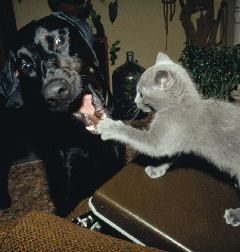28 December 1999
Cat Sex
by Kate Melville
 In another huge scientific advance further research into the genome seems to indicate that the sex chromosomes of humans and felines are very similar, despite an evolutionary divide of around 90 million years.
In another huge scientific advance further research into the genome seems to indicate that the sex chromosomes of humans and felines are very similar, despite an evolutionary divide of around 90 million years.
Mammalian X and Y chromosomes emerged about 250 million years ago, not that long after mammals began shaking off their reptilian ancestry. Initially a matched pair, X and Y evolved into the separate sex chromosomes and diverged dramatically in the process. In particular Y has changed its DNA so completely that scientists think the order of its genes could differ even in closely related mammals.
This work was carried out at the US National Cancer Institute using newly available gene localisation tools to compare the relative order of 25 unique DNA sequences (including 19 genes) on the cat, mouse, and human X chromosomes and 8 sequences on the Y chromosomes. Researchers found that humans and cats have pretty much the same gene order on both the X and Y chromosomes, yet the order in mice is relatively shuffled. They also discovered a small block of genes with well-preserved order and spacing in mouse, cat, and human, suggesting that these particular genes have an important function, probably in male reproductive fitness. These indicate that the Y chromosome has conserved itself to an unexpected degree among certain mammals and point to cats as being the most appropriate animal model for human sexual functions - particularly male fertility.
But what happens if men develop a rough tongue and get 8 more lives - does humanity stand a chance?
Related Articles
Cat Parasite Aiming For Global Male Domination
